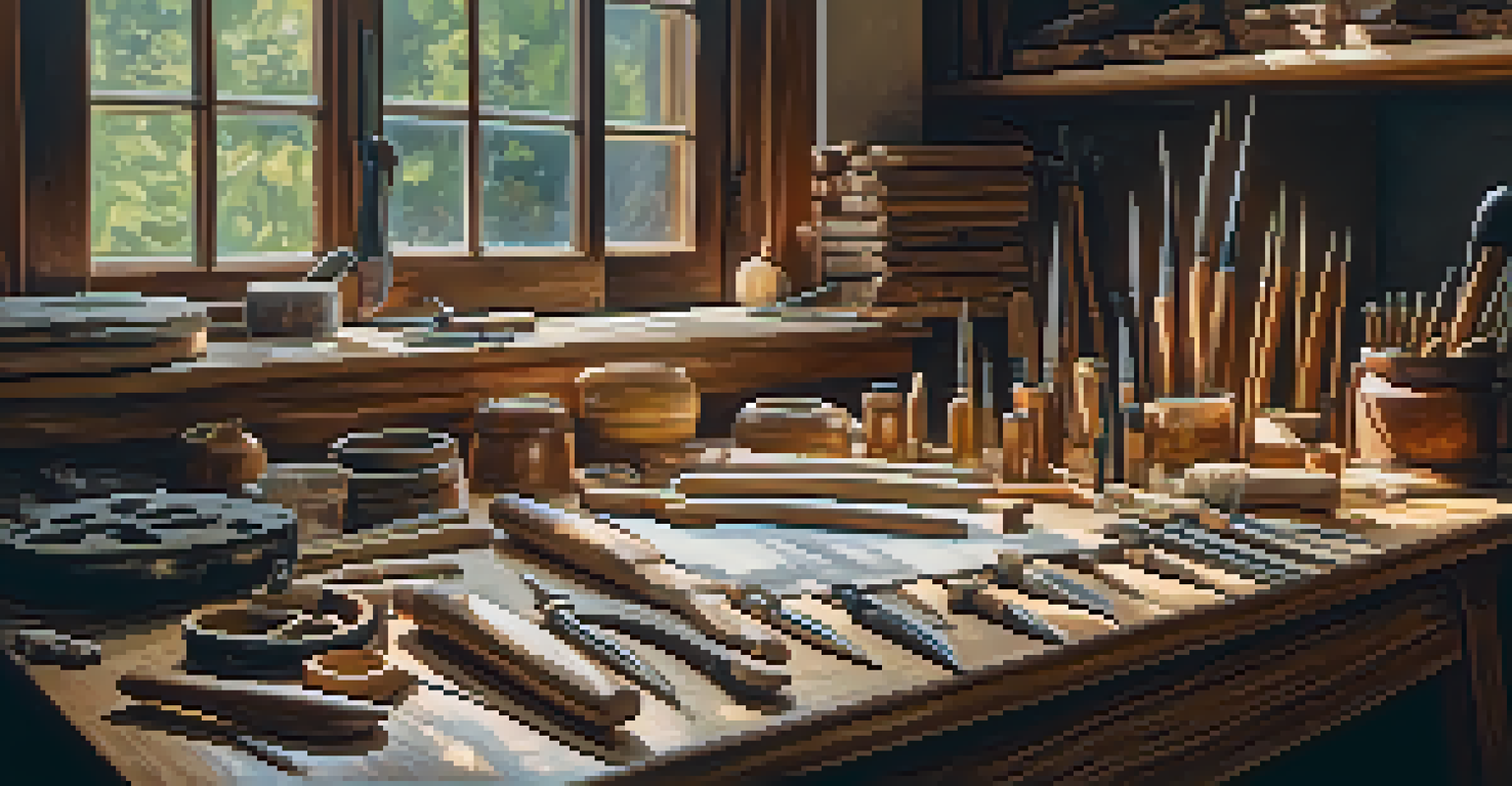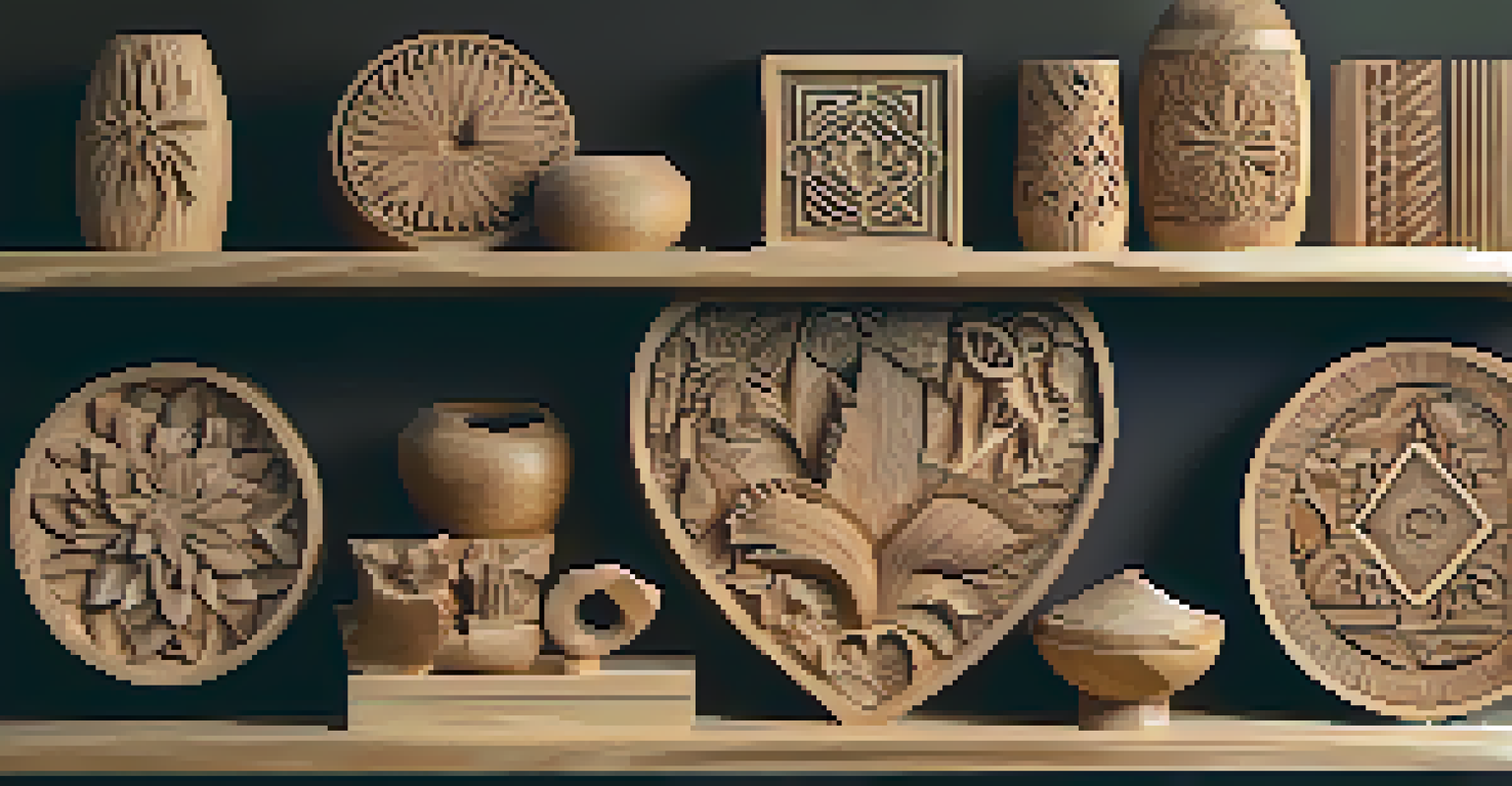Creating Unique Designs: Mixing Wood Carving Techniques

Understanding the Basics of Wood Carving Techniques
Wood carving is an ancient craft that involves shaping wood into artistic forms. By mastering a few basic techniques, you can unlock your creative potential. Techniques like relief carving, chip carving, and whittling serve as the foundation for more intricate designs.
Wood carving is a form of art that requires not only skill but also creativity and patience.
Relief carving, for instance, involves creating a design that pops out from the background, providing depth and texture. Chip carving, on the other hand, focuses on making small, intricate cuts to create patterns. Each technique has its unique charm, making it essential to grasp the fundamentals before diving into more complex designs.
As you begin your journey, consider which techniques resonate with your artistic style. This understanding will guide you in mixing them effectively to create unique, eye-catching pieces that reflect your personality.
Exploring Complementary Techniques for Unique Designs
Mixing wood carving techniques can lead to stunning results. For example, combining relief carving with chip carving can add both depth and intricate detail to your project. This fusion not only enhances visual interest but also allows for creative expression.

Imagine a wooden panel where a beautifully carved scene is surrounded by chip-carved borders. This interplay between the techniques can create a captivating focal point. The key is to experiment and see how different approaches can complement one another.
Master Basic Wood Carving Techniques
Understanding foundational techniques like relief carving, chip carving, and whittling is essential for unlocking your creative potential.
Don't shy away from trying unusual combinations. The beauty of wood carving lies in its versatility, and by mixing techniques, you can craft pieces that are truly one-of-a-kind.
Selecting the Right Wood for Your Carving Techniques
The type of wood you choose significantly impacts your carving experience and the final outcome. Softer woods like pine and basswood are excellent for beginners, as they are easier to carve and less likely to splinter. On the other hand, hardwoods such as oak and maple offer durability and stunning grain patterns.
The best artist has no conception that a marble block does not contain within itself.
When mixing techniques, consider how different woods respond to various carving methods. For instance, hardwoods may challenge you with their density but can yield beautiful results when mastered. Conversely, softwoods allow for more flexibility in experimentation.
Ultimately, the right wood can make all the difference in achieving your desired effects. Take time to explore different types and find what works best for your unique designs.
Tools of the Trade: Essential Carving Tools Explained
Having the right tools is crucial for successful wood carving. Essential tools include chisels, gouges, and knives, each serving specific purposes. A basic set will help you tackle various techniques without feeling overwhelmed.
For instance, a detail knife is perfect for whittling, while a gouge can help you achieve smooth curves in relief carving. Investing in quality tools will not only enhance your skills but also make the carving process more enjoyable.
Choose the Right Wood for Carving
Selecting appropriate wood types influences both your carving experience and the final aesthetic of your project.
As you become more comfortable, you may want to expand your toolkit. Specialized tools can open up new possibilities, allowing you to further blend techniques and create unique designs.
Incorporating Design Principles in Your Carving Projects
Understanding design principles can elevate your wood carving projects. Concepts like balance, contrast, and harmony play a vital role in creating visually appealing pieces. When mixing techniques, these principles help guide your decisions.
For example, consider using contrast to highlight different textures in your design. A smooth, polished section can beautifully offset a rough, textured area created through chip carving. This not only draws the viewer's eye but also enhances the overall aesthetic.
By keeping design principles in mind, you can create more intentional and impactful carvings. This thoughtful approach will set your work apart and resonate with those who appreciate unique artistry.
Finding Inspiration for Your Unique Wood Carving Designs
Inspiration can come from various sources, including nature, architecture, and even everyday objects. Keeping a sketchbook handy allows you to jot down ideas when inspiration strikes. You might find that a beautiful tree's bark pattern inspires a new chip carving design.
Online platforms like Pinterest or Instagram are also great for discovering unique wood carving projects. Observing how other artists mix techniques can spark your creativity and lead to exciting new ideas. Don’t be afraid to put your spin on what you see!
Use Design Principles for Impact
Incorporating design principles such as balance and contrast can elevate your wood carvings and make them visually appealing.
Ultimately, inspiration is about being open to the world around you. By tapping into diverse influences, you can create distinctive designs that showcase your personality and artistic voice.
Showcasing Your Unique Designs: Tips for Presentation
Once you've crafted your unique wood carving, how you present it is just as important as the piece itself. Consider the setting where your work will be displayed. A well-chosen backdrop can enhance the visual impact of your design.
Using natural elements like stone or wood bases can create a harmonious presentation that complements your carving. Additionally, proper lighting can highlight the intricate details of your work, drawing attention to the beautiful textures you’ve created.

Don't forget to share your designs online! Social media platforms provide an excellent opportunity to showcase your artistry and connect with fellow wood carving enthusiasts. This exposure can lead to valuable feedback and even potential commissions.